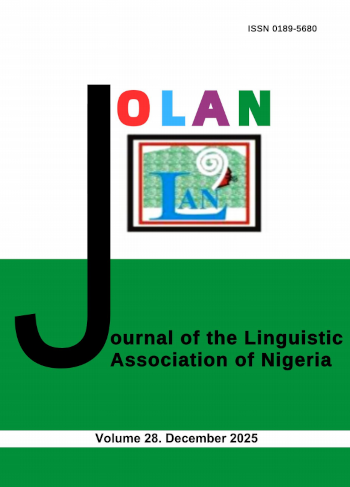A Semiotic Analysis of Non-Verbal Communication Among the Igede of Central Nigeria
Keywords:
Non-verbal communication, signs and symbols, referential theory and pragmaticsAbstract
Communication, being an art and process of passing information or messages, rests on a tripod of channels: written, oral and non-verbal. Humans are gregarious and as such rely on all of these channels of communication in everyday interaction. This paper however, focuses its searchlight on the non-verbal aspect of communication as used among the Igede ethno-linguistic group of Benue State in Central Nigeria. The paper explores how the various linguistic signs and symbols are able to convey information among the people based on their historical and linguistic background as well as their worldview. In achieving this, the referential theory of meaning as enunciated by Ferdinand de Saussure as well as Charles Sandal Pierce’s semiotic theory is adopted. The study discovers that among the Igede people, non-verbal communication serves as a very significant avenue for information dissemination and meaning sharing among the people.
References
Ahmad and Nasir (2011) The Use of non-verbal Communication in Abubakar Gimba’s Witness to Tears. Nigeria Education Forum (19:1) July pp. 1 – 7
Akaan S., Agbedo, C., and Onukawa, M.C., (2013) “Nonverbal Communication: The semiotics of facial Expression in Tiv” In Nsukka Working papers in Languages and Linguistics and Literature vol. 1. 1 % 2 153 – 163.
Akpabia, E. (2003) African Communication System: An Introductory Text. Lagos: B Print Publication.
Burgeon J. K. and Saine, T. (1978) The Unspoken Dialogue: An Introduction to Non-verbal Communication. Baston: Houghton Milflin
Chandler, D. (2014) Semiotics for Beginners. Retrieved 20/9/2016. http:/www.visualmemory.co.UK/Daniel/documents/S4B/semolhtml.
Colman, A.M. (2003) A Dictionary of Psychology. Oxford: Oxford University Press.
Eco, U. (1979) A Theory of Semiotics. Bloomington: Indiana.
Egono, N.G. (2016) “Referential Theory of Meaning” In Mbah B M (ed.) Theories of Linguistics. Enugu: University of Nigeria Press.
Ekman, P. (1994) “Story Evidence for Universalities in Facial Expressions: A reply to Russell’s Mistaken Critiques” Psychological Bulletin. 115, pp: 268-287.
Lyons, J. (1981) Language and linguistics. Cambridge: Cambridge University Press.
Lyons, J. (1981) Language, Meaning and Context. London: Fontana.
Nicholls, R. (1984) ‘Igede Funeral Masquerades’ In African Arts, 17(3). California: University of California, Press.
Odgen, C.K. and Richards, I.A. (1923) Meaning of Meaning. Routtedge.
Ogwezzy, A.O. (2010) African Communication Systems: Concepts, Channels and Messages. Bowie, Maryland (USA): African Renaissance Book Incorporated.
Oloruntoba-Oju, T. (1999) “Understanding Semiotic” In Adegbija E (ed.). The English Language and Literature in English: An Introductory Handbook. Ilorin: University of Ilorin Press.
Payne, J. (2001) Applications Communication for personal and Professional Contexts Topka: Clark Publishing Inc.
Pearsan, J.C., Nelson, P.E., Titsworth, S., and Harter, L. (2003) Human Communication. Boston: McGraw Hill
Schneider, F. (2013). A Rough Guide to the Theory of Semiotics. Retrieved September 22nd, 2016 from http://www.politicalsearstasia.com./wpcontent/uploads/2013/07/characterma400x1276opt.jpg
Westman, R. & Turner, L. (2003) Introducing Communication Theory: Analysis and Application Boston, M.A: McGraw Hill.














